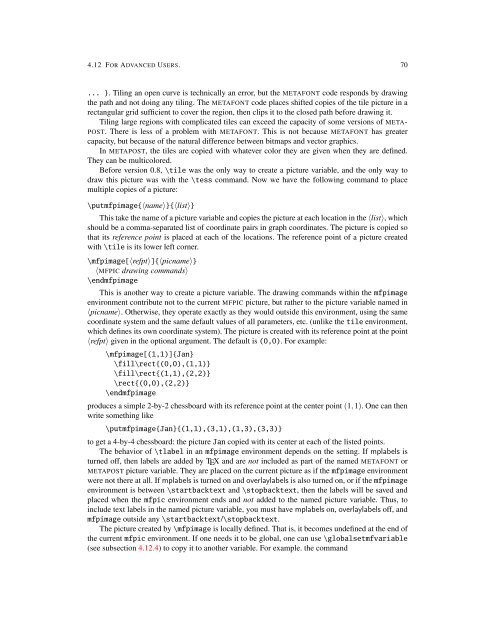You also want an ePaper? Increase the reach of your titles
YUMPU automatically turns print PDFs into web optimized ePapers that Google loves.
4.12 FOR ADVANCED USERS. 70<br />
... }. Tiling an open curve is technically an error, but the METAFONT code responds by drawing<br />
the path and not doing any tiling. The METAFONT code places shifted copies of the tile picture in a<br />
rectangular grid sufficient to cover the region, then clips it to the closed path before drawing it.<br />
Tiling large regions with complicated tiles can exceed the capacity of some versions of META-<br />
POST. There is less of a problem with METAFONT. This is not because METAFONT has greater<br />
capacity, but because of the natural difference between bitmaps and vector graphics.<br />
In METAPOST, the tiles are copied with whatever color they are given when they are defined.<br />
They can be multicolored.<br />
Before version 0.8, \tile was the only way to create a picture variable, and the only way to<br />
draw this picture was with the \tess command. Now we have the following command to place<br />
multiple copies of a picture:<br />
\putmfpimage{〈name〉}{〈list〉}<br />
This take the name of a picture variable and copies the picture at each location in the 〈list〉, which<br />
should be a comma-separated list of coordinate pairs in graph coordinates. The picture is copied so<br />
that its reference point is placed at each of the locations. The reference point of a picture created<br />
with \tile is its lower left corner.<br />
\mfpimage[〈refpt〉]{〈picname〉}<br />
〈MFPIC drawing commands〉<br />
\endmfpimage<br />
This is another way to create a picture variable. The drawing commands within the mfpimage<br />
environment contribute not to the current MFPIC picture, but rather to the picture variable named in<br />
〈picname〉. Otherwise, they operate exactly as they would outside this environment, using the same<br />
coordinate system and the same default values of all parameters, etc. (unlike the tile environment,<br />
which defines its own coordinate system). The picture is created with its reference point at the point<br />
〈refpt〉 given in the optional argument. The default is (0,0). For example:<br />
\mfpimage[(1,1)]{Jan}<br />
\fill\rect{(0,0),(1,1)}<br />
\fill\rect{(1,1),(2,2)}<br />
\rect{(0,0),(2,2)}<br />
\endmfpimage<br />
produces a simple 2-by-2 chessboard with its reference point at the center point (1,1). One can then<br />
write something like<br />
\putmfpimage{Jan}{(1,1),(3,1),(1,3),(3,3)}<br />
to get a 4-by-4 chessboard: the picture Jan copied with its center at each of the listed points.<br />
The behavior of \tlabel in an mfpimage environment depends on the setting. If mplabels is<br />
turned off, then labels are added by TEX and are not included as part of the named METAFONT or<br />
METAPOST picture variable. They are placed on the current picture as if the mfpimage environment<br />
were not there at all. If mplabels is turned on and overlaylabels is also turned on, or if the mfpimage<br />
environment is between \startbacktext and \stopbacktext, then the labels will be saved and<br />
placed when the <strong>mfpic</strong> environment ends and not added to the named picture variable. Thus, to<br />
include text labels in the named picture variable, you must have mplabels on, overlaylabels off, and<br />
mfpimage outside any \startbacktext/\stopbacktext.<br />
The picture created by \mfpimage is locally defined. That is, it becomes undefined at the end of<br />
the current <strong>mfpic</strong> environment. If one needs it to be global, one can use \globalsetmfvariable<br />
(see subsection 4.12.4) to copy it to another variable. For example. the command

















